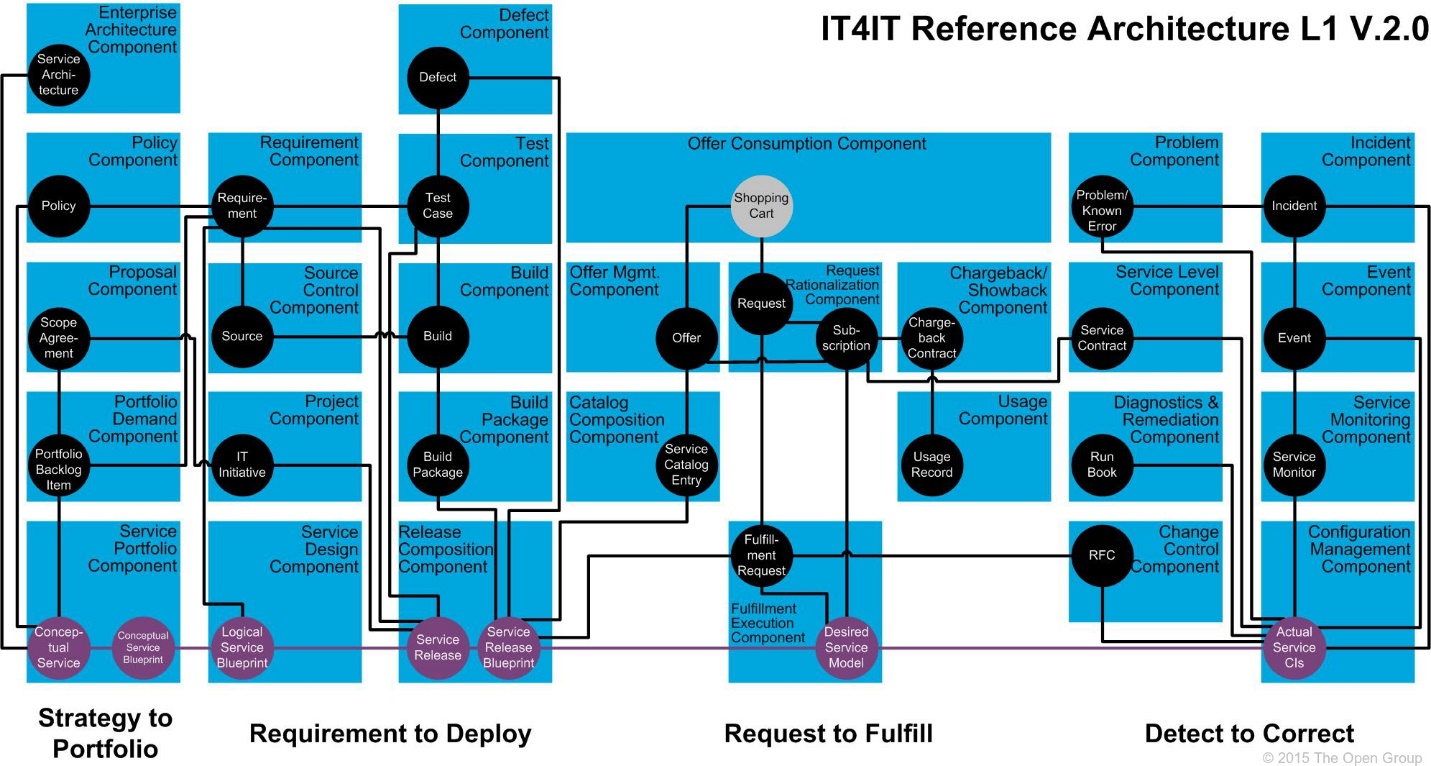
IT4IT 101: A New Approach to IT Development and Delivery
Following on from my previous blogs on DevOps, service integration and management (SIAM), and Agile, here’s another “ITSM approach”-based blog – this time looking at something called IT4IT. Never heard of it? Don’t worry, it’s still pretty new (and don’t worry that IT is mentioned twice in the name – IT4IT is actually all about IT departments better meeting business needs). So let me start with the basics.
Positioning IT4IT
IT4IT is seen as complementary to ITIL, the IT service management (ITSM) best practice framework, with it marketed as a standard like ISO/IEC 20000 or ISO/IEC 38500. It was released by The Open Group in 2015, to focus on defining, sourcing, consuming, and managing IT services across the value stream, i.e. “the services provided by the IT function to the parent organization for use by customers, suppliers, employees, investors, regulators, the media, and any other stakeholders.” The Open Group’s IT4IT standard is comprised of a “reference architecture” and a value chain-based operating model for managing “the business of IT.” Ultimately, it provides prescriptive guidance on how to design, procure, and implement the functionality needed to run IT.
The end-to-end, “how to” emphasis of the IT4IT IT value chain and reference architecture also enables IT organizations to systematically track the state of the services they deliver across the service lifecycle.
So Really, What Is IT4IT?
In a nutshell, IT4IT:
- Is a standard that looks at managing IT services across the service lifecycle
- Is a way to drive efficiencies
- Gives prescriptive guidance on how to provide a service backbone via the use of standard service models
- Supports real-life use cases referencing other frameworks such as DevOps
- Is complementary to ITIL
Consider this the IT4IT elevator pitch, albeit in a very tall building and we’re headed to the top…so bear with me.
The IT4IT reference architecture is best described by way of a picture – 1000 words being painted and all that…
Basic IT4IT Model
Image Source: The Open Group
Key IT4IT Concepts
IT4IT splits the IT value chain into four value streams, supported by the reference architecture:
1. Strategy to Portfolio
The Strategy to Portfolio value stream helps to ensure that your company has the right strategy in place to balance and promote your IT service portfolio. It helps with a consistent strategic view across the project management office (PMO), enterprise architecture (EA), and ITSM teams; and that the right data is available at the right time to support decision making. All too often there can be a disconnect between the PMO, EA, and ITSM teams causing delays at best, and at worst, IT services that aren’t fit for purpose. Having one view in place means that the important stuff is visible to all – so nothing gets missed.
Strategy to Portfolio also ensures that the appropriate key performance indicators (KPIs) are in place to help improve communication with the rest of the business. Because, sometimes as an organization, we can be so focused on proving how good we are, that we fall into the trap of reporting metrics just for the sake of them. By taking the time to map Strategy to Portfolio you can ensure that any KPIs map directly to your critical to quality (CTQ) measures or critical success factors (CSFs) making IT more closely aligned to the rest of the business.
A final point about Strategy to Portfolio is that it ties neatly into Agile/Lean: whereas ITIL can be very theoretical about future services, IT4IT uses the Agile/Lean start-up model of proof by testing a hypothesis – meaning efficiency savings as well as quicker time to market.
2. Requirement to Deploy
Next up is the Requirement to Deploy value stream, which is the part of the standard that helps companies to define, build, test, and deploy the right services, at the right time, and for the right cost. Requirement to Deploy supports both traditional and Agile deployment methods and ensures that both continuous integration and continuous delivery control points are in place.
Having the right balance between governance and delivery is hugely important to the overall success of any project. Not enough by way of requirements means a risk of failed or rolled back deployments, or code that doesn’t deliver what the business wanted. Too many restrictions, coupled with a lack of integration, on the other hand, can cause delays, increased cost, and decreased customer satisfaction.
Every organization is different, so take the time to ensure that your approach has the right balance between the two such that you deliver the best possible outcome to your stakeholders.
3. Request to Fulfill
Then we have the Request to Fulfill value stream, which helps your IT organization to:
- Transition to a service broker model
- Present a single catalog with items from multiple supplier catalogs
- Efficiently manage subscriptions and manage total cost of service
- Manage and measure fulfillment across multiple suppliers
The Request to Fulfill part of IT4IT makes it easier to showcase your IT services. It contains very structured requirements for service catalog creation and is scalable all the way up to the largest of cloud service providers. One of the golden rules of ITSM is to “always make it easy for people to use your services” (see Tip #1 here), so having an actionable, effective service catalog not only showcases those services, it also empowers customers via self-service models – again driving efficiencies and quicker resolution times.
4. Detect to Correct
Finally, Detect to Correct is the value stream that brings together IT operations to effectively detect and correct issues before business users are adversely impacted. It uses a collaborative approach with common language, consistent data, and a shared configuration model to improve service visibility and to reduce the mean time to repair (MTTR).
Detect to Correct is the part of IT4IT that’s most visible to the business. Let’s face it, even with the best will in the world, and the most perfect environment, we will always experience some form of disruption – be it performance issues or downtime. And sometimes it’s not about being perfect all the time but about the way you respond to customer issues. Having a shared language, and data and configuration models, means that a more proactive approach can be taken to incident resolution and we’ll see a reduction in adverse customer impact.
Why Does My Company Need IT4IT?
The reality is that times have changed, with IT now a key business enabler. And to truly deliver value, we need to balance innovation and speed against the need for compliance and risk mitigation. The bigger and more complex your organization is, the greater the opportunity is for IT4IT to help with this balancing act.
And increasingly complex IT estates are here to stay – be it big data, cloud, artificial intelligence (AI), increased regulatory requirements, or the internet of things (IoT), and we need a way of optimizing IT service delivery and the business value they deliver.
IT4IT can help organizations struggling with complexity, governance, and value demonstration, by offering the following benefits:
- A holistic view across the entire IT estate/portfolio, through well-defined functional components and data flows.
- That IT is responsive and aligned with business priorities.
- The opportunity for continuous delivery and service improvement.
- Higher acceptance of IT services and better business alignment.
- That IT investments are aligned with business demands for IT services.
- Faster time-to-market service realization.
- Better cost-effectiveness and improved IT financial management.
- Empowered customers through auto-subscribe and self-service
- Improved IT and business efficiency through better governance and transparent measures.
- Risk reduction.
As with ITIL, your organization could use as little or as much of IT4IT as it needs – tailoring adoption to key pain points and improvement opportunities.
Positioning IT4IT in Your Company
One of the main tenants of ITIL is the concept of utility – in other words, supporting performance and removing constraints. And IT4IT is something that lends itself well to the removal of “pain points” across your IT organization. Plus, sometimes we can get so caught up in the detail, that we forget to look at business objectives – this is where the value streams can be used to great effect.
So, when your business experiences “pain” while engaging with IT, recognize that something is broken at either a people, process, or technology level. Then, by using the IT4IT value stream approach you have a service blueprint – that covers everything from strategy to request fulfillment and CSI – to better understand how things do, and should, work.
A good way to start using IT4IT is to carry out a benchmarking exercise mapping the current architecture and tools against the IT4IT Reference Architecture. This structured approach means that it will be easier to identify activity gaps and the pain points to prioritize. It will also likely identify opportunities for automation within the IT value streams.
Want to Find Out More?
There’s lots of useful information out there, I’d suggest starting with:
- The Open Group IT4IT Forum
- The IT4IT Blog
- The IT4IT discussion group on LinkedIn
Are you already using IT4IT or looking to start using it? What have you achieved so far? Please let me know in the comments!







